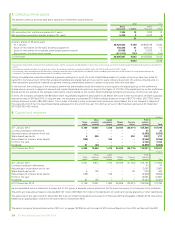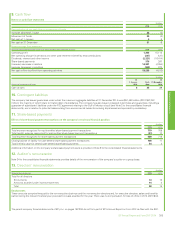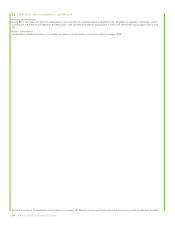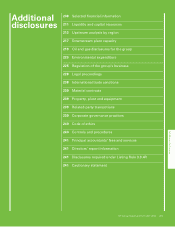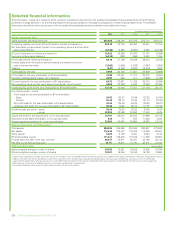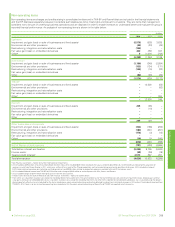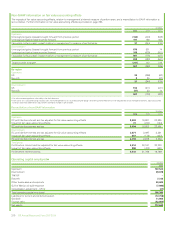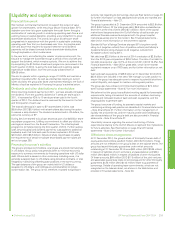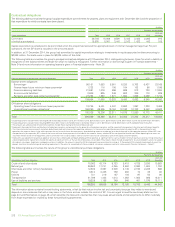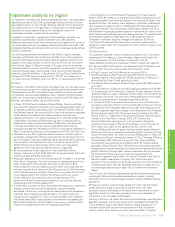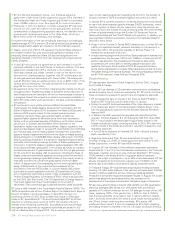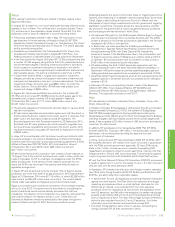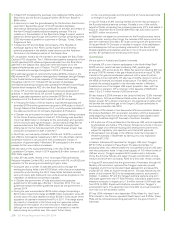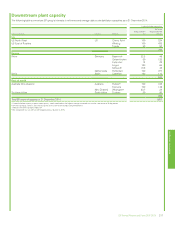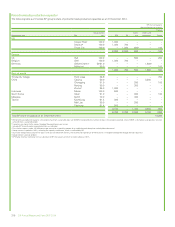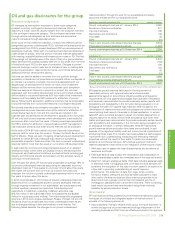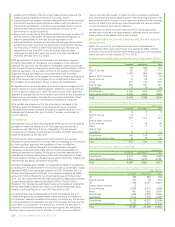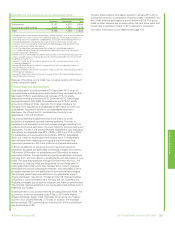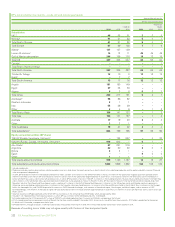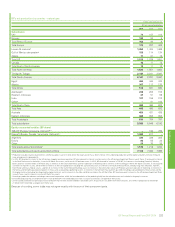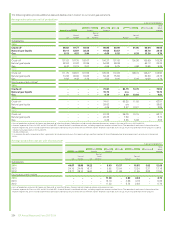BP 2014 Annual Report Download - page 218
Download and view the complete annual report
Please find page 218 of the 2014 BP annual report below. You can navigate through the pages in the report by either clicking on the pages listed below, or by using the keyword search tool below to find specific information within the annual report.
• BP and Pantera Acquisition Group, LLC (Pantera) signed an
agreement under which Pantera agreed to acquire BP’s interests in
the Panhandle West and Texas Hugoton gas fields for a purchase
price of $390 million in June. See page 26 for more information.
• Following on from the decision to create a separate BP business
around our US Lower 48 onshore oil and gas activities, and as a
consequence of disappointing appraisal results, we decided not to
proceed with development plans in the Utica shale, incurring a
$544-million write-off relating to this acreage.
For further information on the use of hydraulic fracturing in our shale gas
assets see page 43. BP’s onshore US crude oil and product pipelines and
related transportation assets are included in the Downstream segment.
In Alaska, at the end of 2014, BP operated nine North Slope oilfields in
the Greater Prudhoe Bay area and owned significant interests in six
producing fields operated by others. BP also owns significant non-
operating interests in the Point Thomson development project and the
Liberty prospect.
• In April BP announced the agreement to sell interests in four BP-
operated oilfields on the North Slope of Alaska to Hilcorp. The sale
agreement included all of BP’s interests in the Endicott and
Northstar oilfields and a 50% interest in each of the Milne Point
field and the Liberty prospect, together with BP’s interests in the
oil and gas pipelines associated with these fields. The sales price
was $1.25 billion plus an additional carry of up to $250 million if the
Liberty field is developed. The sale completed in November. See
page 26 for more information.
• Development of the Point Thomson initial production facility continued
throughout 2014. Engineering design is complete and construction of
field infrastructure and fabrication of the four main process modules is
in progress. Overall, the project is on track to commence production in
2016. BP holds a 32% working interest in the field, and ExxonMobil is
the operator.
• BP continued to work jointly with ExxonMobil, ConocoPhillips,
TransCanada, the Alaska Gasline Development Corporation and the
State of Alaska throughout 2014 to advance the Alaska LNG project. In
February 2013 a lead concept for the project was announced,
consisting of a North Slope gas treatment plant, an 800-mile
(approximately) pipeline to tidewater and a three-train liquefaction
facility, with an estimated capacity of 3bcf/d (up to 20 million tonnes
per annum). In October 2013 selection of the lead site for the
liquefaction facility was announced as Nikiski, Alaska, located on the
south-central Alaskan coast. In January BP, ExxonMobil, ConocoPhillips
and TransCanada, and the Alaska Gasline Development Corporation
signed a heads of agreement (HOA) with the State of Alaska enabling
state participation in the $45-$65 billion Alaska LNG project. The HOA
sets out guiding principles for the parties to negotiate project-enabling
contracts, and provided a roadmap for State of Alaska participation in
the project. In April the Alaska Legislature passed legislation (SB-138)
which approved State participation in the project as a 25% co-investor,
and allowed payment of gas production tax in the form of gas volumes.
On 30 June 2014 the Alaska LNG co-venturers, including the State of
Alaska, executed commercial agreements and launched the pre-front
end engineering and design (pre-FEED) phase of the project, which is
expected to extend into 2016 with gross spend more than $500
million. A decision point for progressing to front end engineering and
design (FEED) phase of the project will be considered at the
completion of the pre-FEED phase. In July the Alaska LNG project
submitted an export application with the US Department of Energy,
and in September submitted a pre-file notice of application with the
Federal Energy Regulatory Commission (FERC), which was approved
by the FERC later that month. The US Department of Energy issued a
Free Trade Agreement Export Authorization to the project in
November. First commercial gas is planned between 2023 and 2025.
BP owns a 49% interest in the Trans-Alaska Pipeline System (TAPS). The
TAPS transports crude oil from Prudhoe Bay on the Alaska North Slope to
the port of Valdez in south-east Alaska. In April 2012 the two non-
controlling owners of TAPS, Koch (3.08%) and Unocal (1.37%) gave
notice to BP, ExxonMobil (21.1%) and ConocoPhillips (29.1%) of their
intention to withdraw as an owner of TAPS. The transfer of Koch’s
interest to the remaining owners (BP, ExxonMobil and ConocoPhillips)
was agreed and approved by regulatory authorities and closed in July
with an effective date of August 2012. The remaining owners and Unocal
have not yet reached agreement regarding the terms for the transfer of
Unocal’s interest in TAPS and related litigation will continue in 2015.
In Canada, BP is currently focused on oil sands development and intends
to use in situ steam-assisted gravity drainage (SAGD) technology, which
uses the injection of steam into the reservoir to warm the bitumen so
that it can flow to the surface through producing wells. We hold interests
in three oil sands leases through the Sunrise Oil Sands and Terre de
Grace partnerships and the Pike Oil Sands joint operation. In addition, we
have significant offshore exploration interests in the Canadian Beaufort
Sea and in Nova Scotia.
• Phase 1 of the Sunrise Oil Sands SAGD development, in which BP has
a 50% non-operated interest, achieved first steam in the reservoir in
December 2014. The production capacity of Sunrise Phase 1 is
expected to be 60mb/d of bitumen.
• A major seismic programme on the Nova Scotia exploration licenses was
conducted over the summer of 2014 with 7,090km2of wide azimuth 3D
seismic data acquired. The processing of this seismic data will be
completed by the end of 2015 to identify possible exploration well
locations. During the fourth quarter of 2014 BP expanded the Nova
Scotia licence participation to include Hess Canada Oil and Gas ULC and
Woodside Energy International (Canada). The new participating interests
are BP 40% (operator), Hess 40% and Woodside 20%.
South America
BP has upstream activities in Brazil, Argentina, Bolivia, Chile, Uruguay
and Trinidad & Tobago.
In Brazil, BP has interests in 22 exploration and production concessions
across six basins, five of which are operated by BP. BP’s entry into five of
these concessions is subject to government and regulatory approvals.
• BP completed the sale of interest in the Polvo oil field (BP 60%) in
Brazil to HRT Oil & Gas Ltda for $135 million in January.
• During the year BP continued appraisal of the Itaipu discovery, located
in the deepwater sector of the Campos basin offshore Brazil, in line
with the appraisal plan approved by the Brazilian National Petroleum
Agency (ANP).
• In October the ANP approved the appraisal plan submitted by the
operator, Petróleo Brasileiro S.A. (Petrobras) for BM-POT-16 and BM-
POT-17 (two blocks in the deepwater Potiguar basin located in the
Brazilian equatorial margin), covering activities to 2018. BP’s farm-in to
a 40% interest in the blocks announced in July 2013 is subject to final
regulatory approvals.
• In July BP had a discovery at Xerelete (BP 18%) in Brazil’s Campos
basin, operated by Total.
In Argentina, Bolivia and Chile, BP conducts activity through Pan
American Energy LLC (PAE), an equity-accounted joint venture*with
Bridas Corporation, in which BP has a 60% interest.
In Uruguay, BP has interests in three offshore deepwater exploration
blocks: blocks 11 and 12 in the Pelotas basin and block 6 in the Punta del
Este basin, together covering an area of almost 26,000km2. BP holds a
100% interest in the blocks and the Uruguayan state oil company,
ANCAP, has a right to participate in up to 30% of any discoveries. BP has
already completed its commitment to acquire over 13,000km2of 3D
seismic data and 3,000km of 2D seismic data by December 2015.
In Trinidad & Tobago, BP holds licences and production-sharing contracts
covering 1.8 million acres offshore of the east and north-east coast. Facilities
include 13 offshore platforms and two onshore processing facilities.
Production is comprised of gas and associated liquids. In August, the Juniper
project was sanctioned and subsequently a key contract for the
development of the project was awarded. Fabrication began in November.
BP also has a shareholding in Atlantic LNG (ALNG), an LNG liquefication
plant that averages 39% across four LNG trainsawith a combined
capacity of 15 million tonnes per annum. BP sells gas to each of the LNG
trains, supplying 100% of the gas for train 1, 50% for train 2, 75% for
train 3 and around 67% of the gas for train 4. All the LNG from Atlantic
train 1 and most of the LNG from trains 2 and 3 is sold to third parties in
the US and Europe under long-term contracts. BP’s equity LNG
entitlement from trains 2, 3 and 4 is marketed via BP’s LNG marketing
and trading function to markets in the US, UK, Spain and South America.
aAn LNG train is a processing facility used to liquefy and purify natural gas in the formation of LNG.
214 BP Annual Report and Form 20-F 2014


